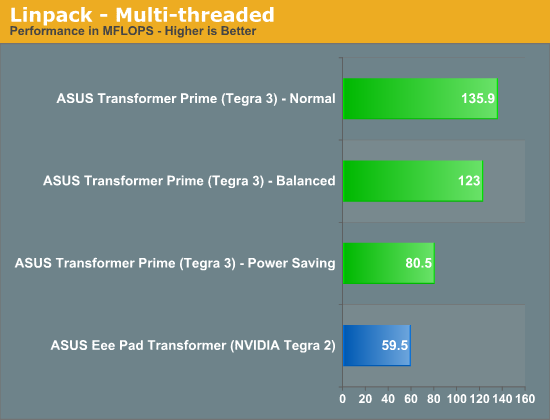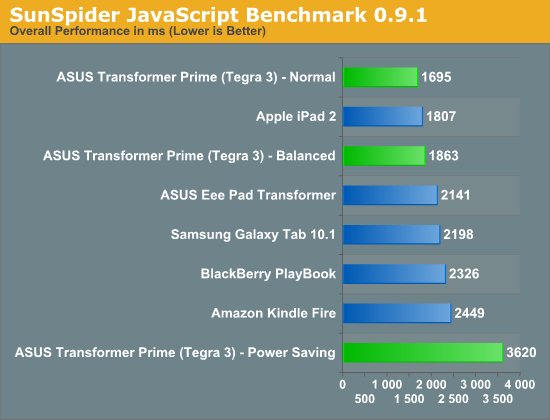ASUS Eee Pad Transformer Prime & NVIDIA Tegra 3 Review
by Anand Lal Shimpi on December 1, 2011 1:00 AM ESTCPU Performance
The big news with Tegra 3 is that you get four ARM Cortex A9 cores with NEON support instead of just two (sans NEON) in the case of the Tegra 2 or most other smartphone class SoCs. In the short period of time I had to test the tablet I couldn't draw many definitive conclusions but I did come away with some observations.
Linpack showed us healthy gains over Tegra 2 thanks to full NEON support in Tegra 3:


As expected, finding applications and usage models to task all four cores is pretty difficult. That being said, it's not hard to use the tablet in such a way that you do stress more than two cores. You won't see 100% CPU utilization across all four cores, but there will be a tangible benefit to having more than two. Whether or not the benefit is worth the cost in die area is irrelevant, it only means that NVIDIA (and/or its partners) have to pay more as the price of the end product to you is already pretty much capped.


The bigger benefit I saw to having four cores vs. two is that you're pretty much never CPU limited in anything you do when multitasking. Per core performance can always go up but I found myself bound either by the broken WiFi or NAND speed. In fact, the only thing that would bring the Prime to a halt was if I happened to be doing a lot of writing to NAND over USB. Keyboard and touch interrupts were a low priority at that point, something I hope to see addressed as we are finally entering the era of performance good enough to bring on some I/O crushing multitasking workloads.

Despite having many cores at its disposal, NVIDIA appears to have erred on the side of caution when it comes to power consumption. While I often saw the third and fourth cores fire up when browsing the web or just using the tablet, NVIDIA did a good job of powering them down when their help wasn't needed. Furthermore, NVIDIA also seems to prefer running more cores at lower voltage/frequency settings than fewer cores at a higher point in the v/f curve. This makes sense given the non-linear relationship between voltage and power.
From a die area perspective I'm not entirely sure having four (technically, five) A9 cores is the best way to deliver high performance, but without a new microprocessor architecture it's surely more efficient than just ratcheting up clock speed. I plan on providing a more thorough look at Tegra 3 SoC performance as I spend more time with a fixed Prime, but my initial impressions are that the CPU performance isn't really holding the platform back.










204 Comments
View All Comments
slayernine - Thursday, December 8, 2011 - link
My local supplied just notified me that Asus has officially delayed shipment of the Transformer Prime due to the same problems Anand experienced with the WiFi speeds. It is currently unknown when they will actually start shipping at this point in time.Romulous - Friday, December 9, 2011 - link
It would seem this new computing space is growing a lot faster than the software is. Therefore, I cannot help feeling it's like having a sports car that you cannot drive anywhere. Great piece of kit, but really, how fast can you browse the web or read text ?I look forward to seeing some serious software vendors coming to the table for this platform. Also, no 3G... really, FAIL.
jcompagner - Sunday, December 11, 2011 - link
http://phandroid.com/2011/12/09/asus-transformer-p...SydneyBlue120d - Tuesday, December 13, 2011 - link
I suggest to add this trailer as the king of Youtube benchmark:http://youtu.be/e-GYrbecb88?hd=1
Can You run correctly at least at 1080p resolution? Thanks a lot